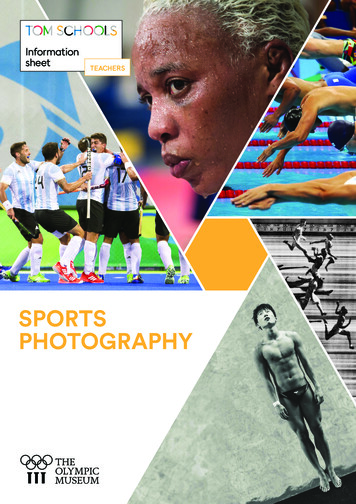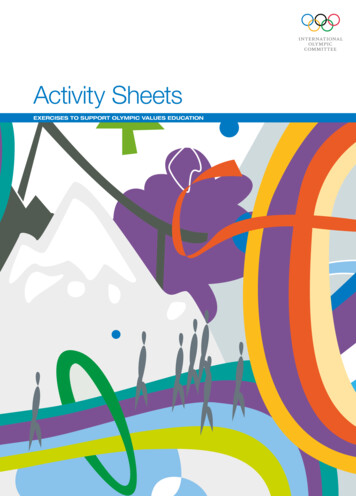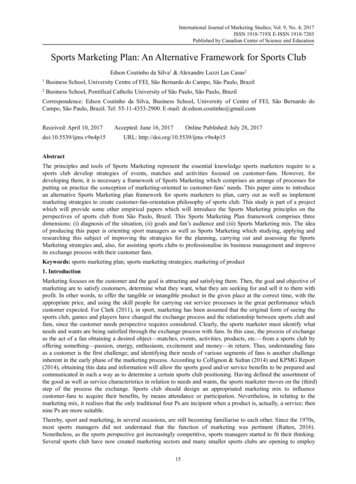
Transcription
InformationsheetTEACHERSSPORTSPHOTOGRAPHY
Information SheetSPORTS PHOTOGRAPHYContentsHow to use this sheet1Introduction2Sports photography, a unique disciplineand a mirror of its timeSports photography, a reflection of the leisured classes4The unique features of sports photography5Sports photography and the Olympic Games9Sports photography and its connectionwith advances in photographic techniquesZoom in on some ground-breaking advances11Role and functions of sporting imagesSports photography, its customs and messages16Sports photography in different contexts18Glossary20Credits21Editor CIO, The Olympic Museum, Lausanne1st edition, 2017AuthorMathilde JomainEnglish TranslationIOC Languages ServicesGraphic DesignDidWeDo s.à.r.l.Images CopyrightsSee Credits on page 21This document is also availablein French and German.It can be downloaded fromwww.olympic.org/education.
Information SheetSPORTS PHOTOGRAPHYHow to use this sheetSports photography is about sharing a moment, an instant in time. It capturesthe intensity of sports competition, and freezes a fleeting moment.It relies on the talent and creativity of the photographers, as well as on thetechnical advances that make it possible to capture those ephemeral eventsand depict them as accurately as possible.This sheet focuses on: The close links between sports photographyand the history of photographic techniques. The documentary and artistic aspects of sports photography. The unique challenges of being a sports photographer. The variety of messages conveyed by images of sport. The different ways sports photographs are used.The activity sheet gives children aged 9 to 15the opportunity to learn more about sportsphotography in a way that brings the topic to life.This document shouldbe used in conjunctionwith the activity sheeton the same topic. Download from: www.olympic.org/education Teaching materialsAn educational video explains how to shoot with short exposures, andprovides the tools for conducting a practical in-class workshop on thevisual image. Available in french from: www.olympic.org/pedagogie
Information SheetSPORTS PHOTOGRAPHYIntroductionSports photography captures an instant of sport, and the people watching it,by conveying a strong image. The photographer is the key person in charge ofthis task, and has many challenges to overcome. It’s by no means an easy job!As sports photographer Franck Seguin says:“Sports photographyis the most difficult field[of photography] because it requiresphysical ability, technical ability (e.g. usingdifferent lenses, studio work and workingoutdoors), the ability to adapt to differentlocations: sea, stadium, mountains, desert,boats, helicopters, etc. That’s the jobof a sports photographer: to producethe best image despite the rulesyou have to follow, andthe many obstacles.”Gail Buckland, Who Shot Sports,A Photographic History, 1843 to the Present,(Knopf, 2016).This expert sports photographer started out photographing skiers becausehe thought it would be a fun way to earn a living!Sports photography has a history all its own. This information sheet gives abrief overview. After an introduction to the history of sports photography andsome of its special features, the second half of the document focuses on theconnections between the discipline and the history of the techniques it relieson. The third part looks at the traditions and messages of sports photography,focusing its main actors: the photographers. Finally, there is a glossary of thekeywords used when analysing an image.2
Sportsphotography,a unique disciplineand a mirrorof its timeBob MartinDiving, Tracey MILES (GBR) with the Sagrada FamiliaIn the background, Barcelona 1992. Getty Images
Information SheetSPORTS PHOTOGRAPHY4Sports photography, a reflectionof the leisured classesBy the end of the 19th century, the industrial revolution had fundamentallychanged western society. These more liberal societies began to turn theirattention to leisure, and devoted more time to recreation and sport. It wasaround that time, in 1894, that Pierre de Coubertin revived the Olympic Games,and global sporting events were now scheduled every four years. This context,which combined technical advances with social liberalisation, contributed tothe rise of sports photography, which continued to develop at an incrediblerate throughout the 20th century.The American delegation posing at the Panathenaic Stadium,during the first modern Olympic Games in Athens in 1896.The rise of Sportsphotography has evolvedincredibly throughoutthe 20th century.
Information SheetSPORTS PHOTOGRAPHYThe uniquefeatures of sportsphotographySpotting the decisive momentPhotographers must use all their intuition to capturethe most powerful instant.Sports photographyfeatures a number ofhighly specific aspects,which form a sort of user’sguide that all good sportsphotographers followto ensure they takephotos that will makean impression.Choosing originalviewpointsThe viewpoint is what givesthe photo its depth.Taking striking portraitsIt gives the photographer an opportunityto identify a more private aspect of the athlete.5
Information SheetSPORTS PHOTOGRAPHYThe decisive momentThe “decisive moment” is a key concept of sports photography.The concept was articulated by French photographer Henri Cartier-Bresson,who identified it as the moment the photographer chooses to capture his image:“Photography implies the recognition of a rhythm in the world of real things.What the eye does is to find and focus on the particular subject within the massof reality; what the camera does is simply to register upon film the decision madeby the eye. (.) In photography there is a new kind of plasticity, the product ofinstantaneous lines made by the movements of the subject. We work in unisonwith movement as though it were a presentiment of the way in which life itselfunfolds. Photography must seize upon this moment and hold immobile theequilibrium of it.”– Henri Cartier-Bresson, Images à la Sauvette (Verve, 1952).Photographersuse their intuitionto capture the mostpowerful instant.This moment is not necessarily themoment when something happens.It could be just before, for example.Photographers use their intuition tocapture the most powerful instant,the most graceful or the most strikingmoment, of a situation. They mustbe able to see how an event is goingto proceed, and choose the mostappropriate moment to capture it ina photograph. That’s not easy!Crossing the finish line, or scoring agoal, are not necessarily the decisivemoments that photographers chooseto immortalise. A photographer islooking for something transcendantal.The best sports photographers arelooking to produce images that areaesthetically powerful, which at thesame time transcend the sportingaction.The photographer hab the perfect viewof this diver preparing to dive below him.Right to the minute!The image’s constructionof those two images wouldnot have been capturedwithout the sharp look andthe intuition of the photographer.Just a fraction of a second earlier, or later, thisimage would lose all its meaning. Perfect timingby photographer Jason Evans!6
Information SheetSPORTS PHOTOGRAPHYViewpointThe viewpoint is the place where the photographerchooses to put his or her camera, and this a crucial elementof sports photography. The viewpoint is what gives thephoto its depth. It can also show a scene from an unusualperspective, which a spectator would not have theopportunity to experience.They are manydifferent viewpoints:- high angle- low angle- aerial view- frontal viewThanks to technical progress, photographers no longerhave to be with their camera to take advantage of themost unusual viewpoints. Cameras can be controlledremotely, mounted on drones, or controlled by computer.Those three pictures illustrate a same moment capturedfrom three different vantage points.7
Information Sheet8SPORTS PHOTOGRAPHYPortraits as sports photographyPortraits focus on the face and its expressions. They are completely differentfrom the kinds of sports photographs that try to capture the body in motion.A portrait givesthe photographer anopportunity to identifya more private aspectof the athlete.They also provide a way for the general public to identify with athletes theyadmire. Portraits are often published in the form of items that can be collectedand kept (stickers, posters, etc.).Whether or not the athlete concerned is famous, a portrait gives the photographeran opportunity to identify a more private aspect of the athlete, and showanother side of their personality.Candid portrait of judoka Yolande Bukasa, a member of the Refugee Olympic Team.This shot was taken during a training session at the 2016 Olympic Games in Rio.
Information SheetSports photographyand the Olympic GamesThe Olympic Games are just as important for photographersas they are for the athletes. They come together for twoweeks every four years, and they need to perform at thehighest level, just like the athletes do. Photographers alsohave to prepare carefully for the Games to keep up withthe pace of competition.The Olympic Games provide an opportunity to try outnew, sometimes experimental techniques. Some cameramanufacturers will lend the photographers new camerasand lenses to try out before they are released onto themarket. It’s a good opportunity to ensure that the professionals use them, and are seen using them on the television!Not a bad marketing strategy.SPORTS PHOTOGRAPHYThe OlympicGames providean opportunity to tryout new, sometimesexperimentaltechniques.Sports photographers have privileged access behind thescenes of the competition, and they provide a glimpseinto a world that is generally closed to spectators. Athletesare seen in a different, more personal light.At the Olympic Games, the photographers also directtheir lenses towards the athletes’ entourage. They mayfocus on the emotions expressed on the faces of the manypeople involved in a sports competition – doctors, coachesand referees – or more generally on the spectators.Photographer John Huet catches the Australian women’s rugby teammoments before they go onto the field for the final. Their faces area picture of concentration.This American coach, surrounded by his team, is talking strategy with hisplayers, who are seen as blurred silhouettes in the foreground.9By using focus and centering the twophotographers chose to emphasizeon one point, which gives a intimistsetting to those pictures.
Sportsphotographyand its connectionwith advances inphotographictechniquesEtienne-Jules MareyUntitled, ca. 1890. Collection Musée Marey, Beaune, France
Information SheetSPORTS PHOTOGRAPHYZoom in on someground-breakingadvancesThe history of sports imageryowes a great deal to the progressmade in photographic techniques.It is also important to note thatsometimes it is the photographersthemselves who pioneeredthese innovations!DaguerreotypeThis process perfected in the late 19th century by LouisDaguerre was a way of creating high-definition imageswithout a negative, on copper plates coated with silver.Daguerreotypes were usually displayed in a glass case,and the reflections this caused meant they had to be tiltedslightly to be seen properly. They were protected fromlight by a wooden lid. This was the beginning ofphotography!Posing chair used for body fixingin the daguerreotype photography.11
Information Sheet12SPORTS PHOTOGRAPHYCalotypeThe calotype was used for the first known sports photograph, taken by DavidOctavius Hill and Robert Adamson. Patented in 1841 by Henry Fox Talbot, itproduced a paper negative, which made it possible to reproduce images bycontact. This was the first photographic development process.The calotypeproduce a papernegative, which makes itpossible to reproduceimages by contact.The first sports photograph shows Mr Laing posing with his tennis racquet,conveying an attitude of strength.Mr Laing had to hold this pose for severalminutes. A hidden metal framework helped toensure he didn’t move. This was the first sportsphotograph!
Information Sheet13SPORTS PHOTOGRAPHYChronophotographyStill at the end of the 19th century, in 1883, Etienne-Jules Marey and hisassistant Georges Demenÿ perfected a way of taking a succession of shotsat fixed intervals. This provided a way of deconstructing movements, makingit possible to study them scientifically. Initially, the various phases of a singlemovement were photographed onto a fixed plate. Later, he would use a movingfilm, with which he could secure up to 50 photos at a rate of 20 images persecond.By deconstructing and studying the movementschronophotography helped athletes to improvetraining.At this time,a film could secureup 50 photos at a rateof 20 imagesper second.Eight in one! With chronophotography, it became possible to isolate every phase of a gymnast rotatingaround a horizontal bar.
Information SheetSPORTS PHOTOGRAPHY1420th century revolutionsA new procedure using silvered glass plates in conjunction with a rapid gelatinemulsion would revolutionise the world of sports photography. Thanks to atechnique perfected by Jules Beau, photographers were finally able to leavetheir studios and capture images of athletes in action. Nevertheless, the early20th century would remain essentially a time of studio portraits. The exposuretime required by early photographic plates meant lengthy poses.Then, little by little, photographers gradually began to seek out originalviewpoints (even without the benefit of telephoto lenses!) and began to exploreconcepts of time and motion thanks to innovations including flash photographyand shorter exposure times.These athletes look as if they’re ready to springforward. But in fact they had to remain motionlessfor several minutes while the photo was taken.Sounds like a recipe for cramp!Anotherrevolutionarrived in the 1980swiththe inventionof digitalphotography.Brilliant colours are a feature of the BMX final at Rio 2016. In fact, this photowas taken with a mobile phone.Another revolution arrived in the 1980s with the invention of digital photography.The time between taking a photo and publishing the shot got shorter andshorter, and at the same time it became possible to freeze dynamic actionshots, and work with remote-controlled cameras mounted on robots anddrones. Sports photographs have become more graphically effective, capturingthe emotion and speed of the moment, in vivid colours.
Pawel KopczynskiMen’s Discus Throw finale, Lawrence OKOYE (GBR),London 2012. IOPP Pool /Getty ImagesRole andfunctionsof sportingimages
Information SheetSPORTS PHOTOGRAPHY16Sports photography:customs and messagesThe functions of sporting imagesSports photography fulfils a number of different functions.First of all there is the aesthetic dimension, emphasisingthe beauty of the athlete’s body, and giving an artisticdepth to the portrayal of movement.Sports photography also has a documentary value. Itrecords the events of a competition and conveys informationabout it to people who were not there, through newspaperreports, for example.Finally, because it provides the ability to understand anddeconstruct movement, or simply because it provides away of precisely establishing who crossed the finish linefirst, sports photography can have a scientific value.David Burnett ticked all the boxes to come up with this uniquely composedimage. Usain Bolt appears to be alone, when in fact the stadium is filledwith several thousand spectators.In the early 20thcentury very fewwomen practiced sport,which is why thereare far fewerphotographsof them.Influence on the image of womenSports photography has also played a role in modernisingthe image of women. The advent of magazines such asFrench publication La vie au grand air, which publishedphotographs of women riding bicycles, helped to promotemore modern representations of women. Nevertheless,in the early 20th century very few women practised sport,which is why there are far fewer photographs of them.The first female international tennis star, Suzanne Lenglen, nicknamed“The Divine”, immortalised mid-stroke.
Information SheetSPORTS PHOTOGRAPHY17The strength of political messagesSports photography can also convey a political message,and the Olympic Games provide some potent examples.The photos of African-American sprinter Jesse Owens,who won four gold medals at the 1936 Games, provideda powerful counter-argument to Nazi theories about thesuperiority of the Aryan race.At the 1968 Olympic Games in Mexico, US athletes TommieSmith and John Carlos, gold and bronze medal-winnersin the 200 metres, used the Olympic podium as a platformto raise their black-gloved fists in protest against theracism and segregation that continued to divide theUnited States. This instant was captured through sportsphotography and published all around the world. Theathletes became iconic figures in the African-Americancommunity’s struggle for equality.This instant wascaptured through sportsphotography and publishedall around the world.The athletes becameiconic figures in theAfrican-Americancommunity’s strugglefor equality.This photo left its mark on history. The now iconic shot reveals nothing of thesanctions the athletes were subjected to as a result of their protest (they werebanned from the Games and ostracised by the media).
Information SheetSPORTS PHOTOGRAPHY18Sports photographyin different contextsSports photographs can be seen in a variety of different situations. They canbe published in specialised magazines or general-interest publications. Theycan also be exhibited in art galleries, or used by scientific research laboratorieslooking into the human body and movement. These are known as differentreading contexts.The birth of the magazineAccompanying as it did the social changes of the end ofthe 19th century, sports photography enjoyed greatervisibility thanks to the birth of the news magazine. Lavie au grand air, founded in 1898, was entirely devotedto sports news, and featured the latest in graphic design.In those days, photography consisted mainly of studiophotographs, because it remained technically verychallenging to create instant shots.Sports photography,a documentary mediumSports photography can of course be appreciated for itsdocumentary and informative function. It provides arecord of sporting news in the same way as a newspaperarticle, or a radio or television programme. PhotojournalistNate Fein won the Pulitzer Prize in 1949, the first timethis press photography prize had been won by a sportsimage, for a photo of baseball player Babe Ruth’s lastprofessional appearance.Sportphotographycan be seenas a workof art.Photographyin an aesthetic contextSports photography also has an aesthetic dimension. Itcan be seen as a work of art and presented as such in agallery or exhibition. Annie Leibovitz, a photographerknown for her portraits of famous people, has also workedat several different Olympic Games.Athlete portraits by Annie Leibovitz, from a temporary exhibitionat the Olympic Museum in Lausanne.
Information SheetSPORTS PHOTOGRAPHYScientific photography:robotics and unusual viewpointsFinally, sports photography can provide an opportunityto appreciate technical prowess and discover uniquepoints of viewes.For example, working with a camera positioned at a remotelocation reveals some unexpected perspectives. Since1992 and the Barcelona Olympic Games, it has becomepossible to shoot swimmers from the bottom of theswimming pool. It’s an unusual effect!These two synchronised swimmers don’t let themselves be put off by the many cameras lyingon the bottom of the pool where they are performing their programme.Sport photographyprovide an opportunityto appreciate technicalprowess and uniquepoints of viewes.19
Information SheetSPORTS PHOTOGRAPHY20GlossaryCompositionPlaneComposition refers to the way photographers arrange theelements of the image they are about to shoot, in order todraw the focus to where they want it to be.A plane is a virtual vertical surface in which people orobjects are arranged. Different planes represent differentdegrees of depth, from the closest (foreground) to thefurthest away (background), with a number of intermediateplanes in between.They have to think about the elements in each of the differentlevels or planes of the photograph – foreground, midgroundand background.Photographers also look at perspective, and the volumeand the depth of the photograph in each plane of the image.Finally, they think about how the image is framed.Photographic genresThere are many different photographic genres, whichfulfil different functions.Artistic photography is the creation of a work of art, tothe extent that it aims to provoke an aesthetic responsein the person looking at the photo.Documentary photography provides the most realisticand neutral images possible in order to record an event.Scientific photographs are, in general, taken by scientiststo use in their research.Frame-within-a-frameThis technique describes how one work is placed withinanother, multiplying the same image infinitely.StagingA staged photograph aims not to capture a moment intime but to tell a story by using tools of composition,lighting and sometimes studio work, including selectedaccessories.ViewpointThe viewpoint is the position chosen by the photographerto photograph his or her subject. The viewpoint conveysa meaning.A high angle shot captures the subject from the top tothe bottom. It can give the impression that the subject issmaller than it really is.A low angle shot is when the subject is captured fromthe bottom to the top, which makes it look bigger.When the photograph is taken from an aeroplane, forexample, this is called an aerial view.A frontal view means placing the camera directly in frontof the subject. It can feel intrusive, but it also brings thesubject closer to the viewer.Post-productionEIn photography, post-production means all the operationscarried out on a photograph between the time the shutteris released and its final publication. These tasks can includeshot selection, photo editing, and working with lighting,contrast, saturation, sharpness and cropping.ShootingShooting is the action of capturing the subject or visualfield that the photographer wishes to photograph.PhotomontagePrintingA composition of several images or parts of images tocreate a new photograph. Photomontage can be accomplished with collage, through the developing processitself or using software. The new work thus has a differentmeaning from that of its original components.Producing paper proofs from an original image that canbe transferred to film or digital media. At the end of the19th century, dry plates were coated with negativeemulsions made of gelatin or silver chloride, to reveal theimages. Cyanotype, another negative monochromeprocedure, produced cyan blue or Prussian blue prints.
Information SheetSPORTS PHOTOGRAPHY21CreditsCOUVERTUREPAGE 9Jason EvansRio 2016 Olympic Games, Hockey Men, Final – Argentina (ARG) 1st, Belgium(BEL) 2nd. Teh team of Argentina (ARG) hug, Manuel BRUNET, Lucas VILA,Juan LOPEZ et Juan GILARDI. 2016 / International Olympic Committee (IOC)John HuetRio 2016 Olympic Games, Men’s basketball final – United States (USA) 1st,Serbia (SRB) 2nd. Mike Krzyzewsi, the US coach. 2016 / International Olympic Committee (IOC)David BurnettRio 2016 Olympic Games, Judo women’s -70kg (middleweight), training –Yolande BUKASA (ROT). 2016 / International Olympic Committee (IOC)David BurnettRio 2016 Olympic Games, Swimming, 50m freestyle Men, Qualification– Meli MALANI (FIJ) (golden swim cap), Ahmed ATTELLESEY (LBA) (blackswim cap) and Dulguun BATSAIKHAN (MGL) (red swimming suit). 2016 / International Olympic Committee (IOC)AnonymousLondon 1948 Olympic Games – Photo finish of the men’s 100m final. 1948 / Comité International Olympique (CIO)Jason EvansRio 2016 Olympic Games, Diving, 10m platform Men, Training – HaramWOO (KOR) at the start of his dive. 2016 / International Olympic Committee (IOC)PAGE 3Bob MartinDiving, Tracey MILES (GBR) with Sagrada Familiain the background, Barcelona 1992 Olympic Games. Getty ImagesPAGE 4Athens 1896 Olympic Games – The American delegation insidethe Panathenaic Stadium. 1896 / International Olympic Committee (IOC)PAGE 6Jason EvansRio 2016 Olympic Games, diving – Training session: two divers from theDemocratic People’s Republic of Korea train on the trampoline. 2016 / International Olympic Committee (IOC)Jason EvansRio 2016 Olympic Games, diving – Training session: two divers from theDemocratic People’s Republic of Korea train on the trampoline. 2016 / International Olympic Committee (IOC)PAGE 7Matthew KingRio 2016 Olympic Games, athletics, 100m Women finale– Elaine THOMPSON (JAM) 1st, Tori BOWIE (USA) 2nd,Shelly-Ann FRASER-PRYCE (JAM) 3rd. 2016 / International Olympic Committee (IOC)Matthew KingRio 2016 Olympic Games, athletics, 100m Women finale– Elaine THOMPSON (JAM). 2016 / Comité International Olympique (CIO)Ian WaltonRio 2016 Olympic Games, athletics, 100m Women finale –Elaine THOMPSON (JAM) 1st, Tori BOWIE (USA) 2nd,Shelly-Ann FRASER-PRYCE (JAM) 3rd. 2016 / Getty ImagesPAGE 8David BurnettRio 2016 Olympic Games, Judo women’s -70kg (middleweight), training –Yolande BUKASA (ROT). 2016 / International Olympic Committee (IOC)John HuetRio 2016 Olympic Games, Women’s rugby sevens finals – Australia (AUS) 1st,New Zealand (NZL) 2nd. Entrance of the Australian team. 2016 / International Olympic Committee (IOC)PAGE 10Etienne-Jules MareyUntitled, ca. 1890. Collection Musée Marey, Beaune, FrancePAGE 12David Octavius Hill and Robert AdamsonMr. Laing or Laine, 1843. National Galleries of ScotlandPAGE 13Georges DemenyChronophotograph of an Exercise on the Horizontal Bar, 1906. INSEP IconothèquePAGE 14Athens 1896 Olympic Games, Athletics – Herbert Jamison (USA), RobertGarrett (USA), Francis Lane (USA) and Albert Tyler (USA). In the startingblocks. 1896 / International Olympic Committee (IOC)John HuetRio 2016 Olympic Games, BMX cycling, men’s individual final. 2016 / Comité International Olympique (CIO)PAGE 15Pawel KopczynskiLondon 2012 Olympic Games, Men’s Discus Throw finale – Lawrence OKOYE (GBR). IOPP Pool / Getty ImagesPAGE 16David BurnettRio 2016 Olympic Games, athletics, 200 m men’s final – Usain BOLT (JAM) 1st. 2016 / Comité International Olympique (CIO)AnonymousAntwerp 1920 – Suzanne LENGLEN (FRA), gold medallist, singles and mixed doubles. Getty ImagesPAGE 17Mexico 1968 Olympic Games, Athletics, men’s 200 m medal ceremony –Peter Norman (AUS) 2nd, Tommie Smith (USA) 1st and John Carlos (USA) 3rd. 2017 / International Olympic Committee (IOC) / United ArchivesPAGE 18Catherine Leutenegger“Olympic’Art” temporary exhibition, Olympic Museum Lausanne, 20/11/2008- 01/03/2009 – “Modern pentathlon, Michal Gostigian” (left) and “Athletics,Gwen Torrence” (right), 1996, taken by Annie Leibovitz (1949–), USA. 2009 / International Olympic Committee (IOC)PAGE 19John HuetLondon 2012 Olympic Games, Synchronised swimming, duet women’s final– Xuechen Huang and Ou Liu (CHN), 3rd. 2012 / International Olympic Committee (IOC)
The unique features of sports photography 5 Sports photography and the Olympic Games 9 Sports photography and its connection with advances in photographic techniques Zoom in on some ground-breaking advances 11 Role and functions of sporting images Sports photography, its customs and messages 16 Sports photography in different contexts 18










